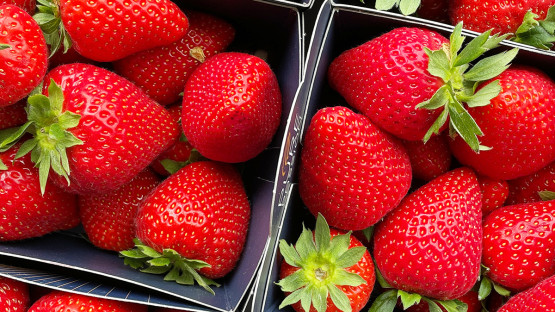
If you would like to learn more about the IAEA’s work, sign up for our weekly updates containing our most important news, multimedia and more.
Streamlining Food Pest Control Through Irradiation
Joanne Liou

Irradiation helps make it possible for food products, like strawberries, to stay fresh and last long journeys. (Photo: R. Mithare/Unsplash)
There is more than meets the eye when it comes to the spices, seeds, fruits and vegetables that travel from distant origins to your local grocer. A small dose of radiation helps make it possible for food products to stay fresh and last the journey without spreading invasive organisms.
The IAEA, in partnership with the Food and Agriculture Organization of the United Nations (FAO), is supporting the latest developments in the fields of food and phytosanitary irradiation, in order to help streamline the pest control process and facilitate international trade. Food and phytosanitary irradiation are post-harvest treatments that use ionizing radiation produced by a source, such as cobalt-60, or generated by accelerators.
“Ionizing radiation is gentle on food, but not on microbes or invasive pests, and it enables international trade,” said Carl Blackburn, Food Irradiation Specialist at the Joint FAO/IAEA Centre of Nuclear Techniques in Food and Agriculture.
Ionizing radiation is gentle on food, but not on microbes or invasive pests, and it enables international trade.
In-house irradiation devices
Before being shipped to their final destination, certain food products are first prepared or collected from their place of origin, packaged, and then taken to an irradiation facility. These facilities often rely on cobalt-60 as the source of ionizing radiation. “Colbalt-60 is easy to use for gamma rays, but it might be challenging to procure and transport,” Blackburn said. “The IAEA has been encouraging a new streamlined approach, bringing irradiation in-house with soft radiation, like low energy electron beams (LEEBs) and low energy X-rays, where the irradiator can be placed inside a food factory or packing house.”
In 2021, an IAEA coordinated research project demonstrated the feasibility of using LEEBs and soft X-rays to reduce infestation and microbial contamination. “This means that low energy electron beams, or soft electrons, can be applied as a surface treatment, and they do not affect qualitative properties,” said Setsuko Todoriki, a project participant and Research Lead at the National Agriculture and Food Research Organization in Japan. “Because of the significantly lower energy in comparison to conventional electron beams, low energy electron beams could be implemented into the processing line and operated on site.” The project developed dosimetry methods for soft X-rays. A new and ongoing coordinated research project devoted to low energy beam treatments is further developing and promoting the innovation of in-house radiation processing of foods, including the development of dosimetry tools and techniques for LEEBs for specific foods, in collaboration with food industry partners.
Developing generic treatments
Over the past 15 years, the volume of commodities irradiated for phytosanitation has increased significantly to nearly 100 000 tonnes per year globally. However, traded irradiated food products are only a slim fraction of those treated by other phytosanitary measures. The volume of mangoes that undergo hot water treatment in Mexico alone, for example, amounts to about 300 000 tonnes per year, explained Guy Hallman, a phytosanitation expert based in the United States of America. “Phytosanitary irradiation has advantages over other phytosanitary treatments, such as cold, heat and fumigation, which may alter the taste or texture of foods,” Hallman said. Having more internationally accepted standards for irradiation could support the further uptake of this treatment option and increase trade, he added.
The International Plant Protection Convention (IPPC), a multilateral treaty administered by the FAO, establishes standards to prevent and control the spread of pests. Blackburn said that these standards are the bedrock of all bilateral trade agreements for treated fruit and vegetables, but irradiation treatment standards only cite radiation doses that are species specific. Just 2 out of the 19 irradiation treatments recognized by the IPPC are generic treatments that prevent fruit flies from being able to spread through trade in fresh produce and reproduce in new locations where they could devastate farming and the environment.
In February 2022, the IAEA launched a coordinated research project to address this and develop at least five generic phytosanitary irradiation treatments for adoption by the IPPC to boost the commercial use of phytosanitary irradiation. These new generic irradiation treatments could potentially address more than 90 per cent of the quarantine issues encountered by traded fruits and vegetables, Blackburn said.
Radiation to sterilize healthcare products
Beyond the sanitary, food quality and phytosanitary uses, much higher dosage radiation technology has been used to sterilize health care products since the 1950s. Radiation treatment is part of the manufacturing process for nearly half of all single-use products in the medical field, such as bandages, gloves, gowns, face masks, syringes and other equipment. Radiation sterilization destroys contaminating microorganisms, while preserving the properties and characteristics of the product.
“Almost 50 per cent of medical products are being sterilized by radiation technologies — gamma, electron beam and X-rays — and it is a growing trend,” said Celina Horak, Head of the Radioisotope Products and Radiation Technology Section at the IAEA. “Additionally, ionizing radiation has been an effective and established tool for sterilizing personal protective equipment (PPE), which has been in high demand during the COVID-19 pandemic.”
In 2020, following the onset of the pandemic, the IAEA studied the feasibility of sterilizing used medical equipment with ionizing radiation. The study concluded that there is potential to reuse irradiated medical protective clothing, except for respiratory face masks such as N95 and FFP2 masks. The study found that used masks that had been irradiated “showed a significant decrease in filtration efficiency in the submicronic domain.” This decrease is likely due to changes in the electrostatic properties of the filter caused by irradiation.





